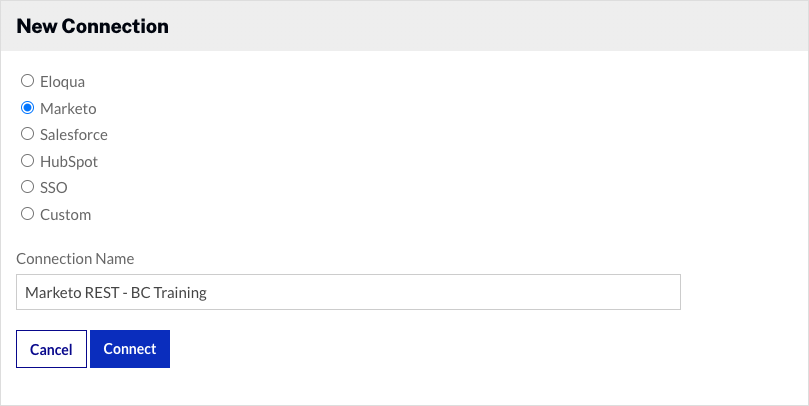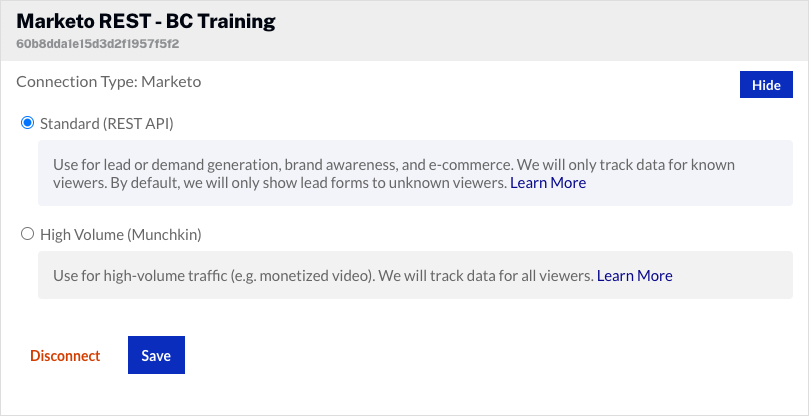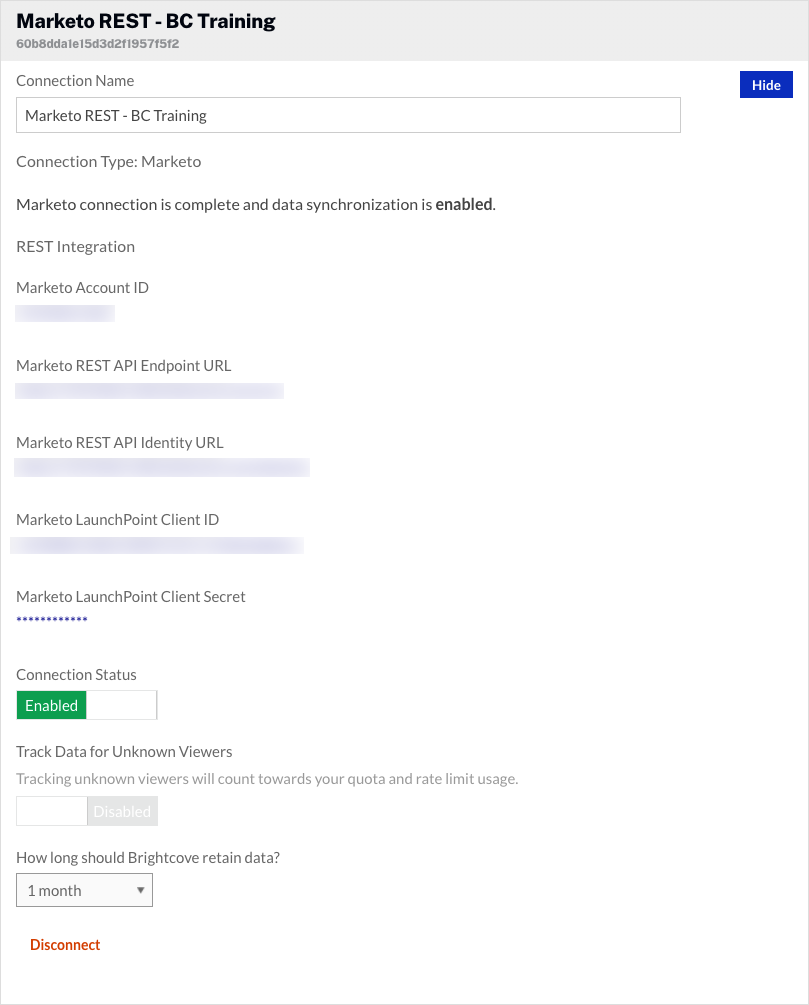Integrating Video Cloud with Marketo Using the REST APIs
The Campaign module allows Video Cloud to synchronize viewing data from Brightcove Players to Marketo. Once in Marketo, this data can be used for segmentation, campaign logic, reports, lead scoring, and personalizing communications.
The Campaign module integration with Marketo consists of two main components:
- A Brightcove Player plug-in to enable tracking of video views data
- A Synchronization process to send tracking data from Video Cloud to Marketo
Requirements
To use the Campaign module with the Marketo REST integration, you must:
- Create a role in Marketo which has access to all of the API permissions
- Create a LaunchPoint Service
- Have a Professional or Enterprise Video Cloud account
- Have the Campaign module enabled for your account by submitting the required information in the initial splash screen that appears when you open the Campaign module
- Click through the service agreement the first time you use the module
- Use the Advanced Embed (in-page) publishing code when publishing your player; Standard Embed (iframe) publishing code will not work as the plugin will be running inside of an iframe and therefore will be unable to access any parent page URL parameters and may not get the correct cookies
Creating an API-only user and LaunchPoint service
Before you can make a call to the Marketo REST API, you need to create a new API role with access to all of the APIs, create an API-only user and then create a service that uniquely identifies your client application. The steps to complete these tasks are outlined in the Marketo documentation.
Setting up the connection
Once the configuration steps on the Marketo side have been completed, follow these steps to setup the connection between Video Cloud and Marketo.
Establishing the connection between Video Cloud and Marketo
- Open the Campaign module.
- In the left navigation, click Data Connections.
- Click .
- Select Marketo as the integration.
- (Optional) Enter a Connection Name.

- Click .
- Select Standard (REST API) and then click .

You will required to paste in several values from your Marketo account. Note that you must be logged in as a Marketo administrator to complete the following steps. For the following steps, click the empty link and provide the appropriate value:
- Marketo Account ID - To get this value, in Marketo click Admin > Integration > Munchkin.
- Marketo REST API Endpoint URL - To get this value, in Marketo click Admin > Integration > Web Services.
- Marketo REST API Identity URL - To get this value, in Marketo click Admin > Integration > Web Services.
- Marketo LaunchPoint Client ID - To get this value, in Marketo click Admin > Integration > LaunchPoint and then click the View Details link for the LaunchPoint you created earlier as part of this setup.
- Marketo LaunchPoint Client Secret - To get this value, in Marketo click Admin > LaunchPoint and then click the View Details link for the LaunchPoint you created earlier as part of this setup.
- Click .
The Video Cloud connection to Marketo is now set up and ready to use.
Configuring the integration
Once the Video Cloud to Marketo connection has been made, you can configure the integration.

- By default, the Connection Status will be Enabled. The Connection Status determines if Video Cloud video engagement data is sent to Marketo.
- Enabled - Data is collected and will be sent to Marketo
- Disabled - No data is collected (integration is disabled)
- By default, Track Data for Unknown Viewers will be set to Disabled. Enabling this option will track data for unknown users. Data will be retained based upon the selected data retention policy. If data retention is set to No retention, this field is not displayed.
- Select a data retention policy. The data retention policy determines whether, and for how long, the lead information data that you capture will be retained in your Video Cloud account as well as in Marketo. Data collected can optionally be retained in Video Cloud for up to 1 month. Retaining data in Video Cloud allows you to recover from interrupted synchronizations. However, you should adjust the retention settings according to your privacy policy - it is not required to retain any user data in Video Cloud. Data will be deleted after the data retention period.

To remove the integration with Marketo, click .
Creating a Campaign-enabled player
Video engagement data will only be sent to Marketo when you are using a Campaign-enabled video player. For information on creating a Campaign-enabled Brightcove Player, see Creating a Campaign-enabled Player.
Identifying viewers
Campaign-enabled players with a Marketo integration will refer to the Munchkin cookie (_mkto_trk) which is created in the user's browser. This value is captured in the Campaign module’s viewing data and is used to synchronize viewing data to Marketo.
The user's email address can be passed in a bcemail URL parameter on the page that is displaying the video. For more information and an example, see How the Campaign Module Identifies Viewers.
Verifying the integration
When the integration is configured, test the integration to confirm that video view data is being sent to Marketo. For information on verifying the integration, see Marketo REST Integration Testing Guide.
